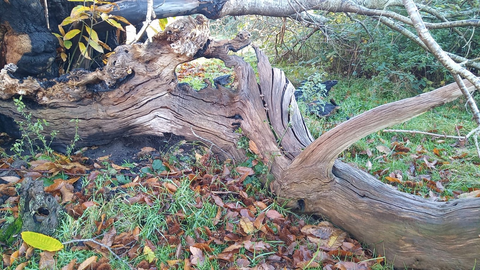© Ian Rickards
Kent Wildlife Trust’s volunteers plant trees to celebrate National Tree Week
© Ben Porter
National Tree Week is the UK’s largest annual tree celebration. Each year, the country’s conservation sector, volunteer groups, and tree-lovers come together to plant thousands of trees to mark the start of the tree planting season.
On Wednesday, 29th November, a group of volunteers will be heading to Fackenden Down to plant saplings on the chalk downland site situated on the Darent Valley, an Area of Outstanding Natural Beauty. Over the years it is hoped the trees will support the precious wildlife that seek refuge at the nature reserve.
In addition to the planting, staff at Kent Wildlife Trust have been sharing their favourite trees on social media, with one in particular, an ancient tree on land bordering Hothfield Heathlands Nature Reserve in Ashford, becoming popular with followers.
The post, which has already racked up 5,000 likes, shows the mighty ancient tree, thought to be a sweet chestnut, with a twisted trunk, resembling an elephant. Such was the popularity, Area Manager Ian Rickards was tasked with taking some additional images of the giant ancient specimen, however, on arrival at the location, he was met with a devastating sight. The tree, which is hundreds of years old, had been burnt to the ground, with the branch that once formed the elephant's trunk left in ashes on the ground.

Ian said: “I’m devastated by the destruction of this stunning tree; it had stood the test of time, though we can take comfort in the fact it was one of a line of four and the other ancient trees remain.
“It would have been planted as cover for livestock or to create an interesting landscape for the lord of the manor. It had grown out in the open, developing a huge trunk and sprawling thick limbs. Over time teeth marks from livestock cause the trunk to create epicormic growth - bark and buds overgrowing the areas where sheep and cattle have nibbled. This often causes the trunk to expand into all sorts of interesting shapes.
“Storms and lightning strikes had damaged its limbs and, with a lucky sequence of events, it ended up creating the illusion of an elephant. What is particularly sad in this instance, is that I do not think this damage is the result of a lightning strike as it is surrounded by taller trees, I believe it has been lost through a mindless act of arson, by someone who wanted to prevent others from enjoying the wonder of nature.”
Veteran trees are important for wildlife. The holes, cracks, and gaps contained in them create nesting opportunities for birds, mammals, and thousands of insects. The rotting wood allows fungi to develop, which in turn creates homes for burrowing beetles.
Ian added: “Species such as barn owls and tawny owls rely on big old trees to create the perfect nesting holes, but a lack of veteran trees has made these species more and more reliant on artificial nest boxes.
“These superb trees are often damaged through activities like soil compaction which can be a result of nearby road or house building or getting swamped by faster-growing tree species like sycamore and birch.”
Kent Wildlife Trust is currently supporting a campaign to Save Oaken Wood, an ancient woodland in Aylesford which is under threat of a quarry expansion. The potential destruction of the woodland is described as the single biggest development threat to ancient woodland of the century. To find out more about the campaign, visit our website.